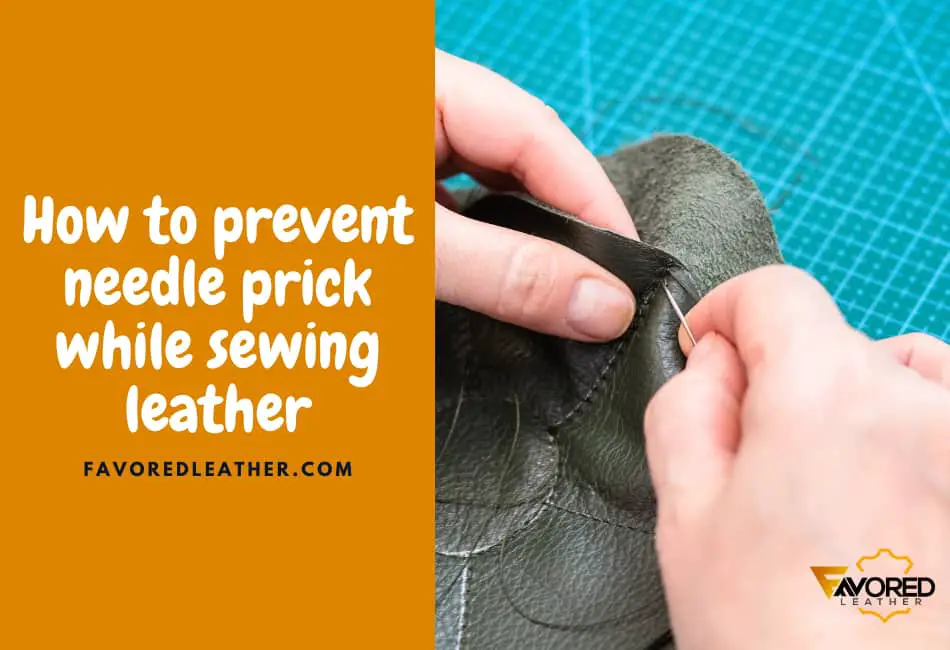If you’re getting into leather crafting, you’ll quickly find that hand stitching is a key part of the process. However, one common challenge that many crafters face is accidentally getting poked by needles.
It’s an issue that can be both frustrating and painful. To help you avoid this, I’ve put together some practical tips that can make your stitching safer and more enjoyable.
1. Dull the Needle Slightly
One of the first things I found helpful was dulling the needle just a bit. I know it sounds counterintuitive, but by taking a fine piece of sandpaper and lightly rubbing the tip, I’ve reduced the number of accidental pokes.
The needle still goes through the leather smoothly, but it’s less likely to pierce my skin. It’s a simple tweak, but it’s made a big difference in my crafting experience.
2. Select the Right Type of Needle
Another important tip is choosing the right type of needle for your project. In leather hand sewing, you usually pre-punch the holes before stitching, so the needle doesn’t need to be overly sharp.
That’s why I prefer using needles with a more rounded tip, often called blunt or ballpoint needles. These needles are designed to glide through the pre-made holes without piercing the leather further or poking your fingers.
By selecting a needle with a rounded tip, you can reduce the risk of accidental pokes and make your stitching process much smoother.
3. Ensure Good Lighting
Good lighting is another essential factor that can make a big difference in your leather crafting experience.
I’ve found that having bright, focused light on my work area helps me see exactly where the needle is going, reducing the chances of poking myself.
Whether you’re working during the day or at night, make sure your workspace is well-lit. A desk lamp with an adjustable arm works great because you can direct the light right where you need it.
With better visibility, you’ll have more control over your stitching and fewer mishaps along the way.
4. Maintain Good Sitting Posture
Maintaining good sitting posture is something I quickly learned to prioritize during long crafting sessions.
When you’re sitting comfortably with proper posture, you have better control over your tools, which can help prevent accidents like needle pokes.
I make sure to sit with my back straight and my work at a comfortable height, which reduces strain and helps me stay focused.
If you’re hunched over or sitting awkwardly, it’s easy to lose precision and end up poking yourself. So, take a moment to adjust your seating and workspace—it’ll make your crafting safer and more enjoyable.
5. Avoid Sewing When Tired
One of the most important lessons I’ve learned is to avoid sewing when I’m tired. Fatigue can seriously affect your concentration and precision, making it more likely that you’ll slip up and poke yourself with a needle.
I’ve found that when I’m well-rested and alert, my stitching is much more accurate and smooth. So, if you’re feeling worn out, it’s better to take a break and come back to your project later.
By sewing when you’re refreshed, you’ll not only avoid accidents but also produce higher-quality work.
6. Use a Stitching Pony
Using a stitching pony has been a game-changer for me in leather crafting. This handy tool holds your leather securely in place while you sew, freeing up both hands to focus on stitching without the worry of accidentally poking yourself.
With the leather firmly clamped, I can concentrate on making precise stitches, and it’s much easier to keep my fingers out of harm’s way.
If you haven’t tried a stitching pony yet, I highly recommend it—it makes the whole process more controlled and safer.
7. Use a Thimble or Finger Guards
Another simple but effective way to protect yourself from needle pokes is by using a thimble or finger guards.
These protective tools act as a barrier between your fingers and the needle, giving you the confidence to push through tougher areas without worrying about getting hurt.
I usually wear a thimble on the finger I use to push the needle and finger guards on any fingers that are likely to be in the needle’s path.
It might take a little getting used to, but once you do, you’ll find it makes hand stitching much safer and more comfortable.
8. Slow Down
Sometimes, the best way to avoid needle pokes is simply to slow down. It’s easy to rush through stitching, especially when you’re eager to finish a project, but hurrying often leads to mistakes.
I’ve learned that by taking my time and focusing on each stitch, I have better control over the needle and can avoid accidents.
Slowing down also helps me enjoy the process more, turning what could be a frustrating task into a relaxing one.
So, give yourself the time you need to work carefully and deliberately—it’ll make your stitching safer and your results more precise.

